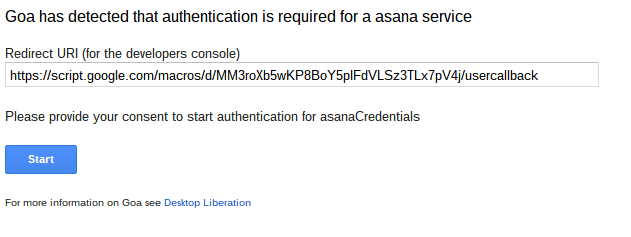This describes how to use the Asana service to authenticate with Asana using Goa, as described in Oauth2 for Apps Script in a few lines of code (which you should read first for background).
The library, cGoa, is available under this project key.
MZx5DzNPsYjVyZaR67xXJQai_d-phDA33
Setting up
You’ll need to create an App. The dashboard can be found here. Your one time setup would look something like this.
cGoa.GoaApp.setPackage (propertyStore ,{
clientId: "33654442426661",
clientSecret:"6ab682baab027c35312ed0cbad72adc3",
scopes : [],
service: "asana",
packageName: "asanaCredentials"
});
The example
The example includes 3 functions.
- A doGet example for a web app.
- An example where the token has already been setup by a one off doGet example
- An example of consuming the token
function doGet(e) {
return doGetAsana (e);
}
and will create a consent screen like this, from which the redirect URI can be copied and added to the App dashboard

The code
/**
* this is how to do a webapp which needs authentication
* @param {*} e - parameters passed to doGet
* @return {HtmlOurput} for rendering
*/
function doGetAsana (e) {
// this is pattern for a WebApp.
// passing the doGet parameters (or anything else)
// will ensure they are preservered during the multiple oauth2 processes
// change this to whatever store & credentials name are being used
var goa = cGoa.GoaApp.createGoa('asanaCredentials',PropertiesService.getScriptProperties()).execute(e);
// it's possible that we need consent - this will cause a consent dialog
if (goa.needsConsent()) {
return goa.getConsent();
}
// if we get here its time for your webapp to run and we should have a token, or thrown an error somewhere
if (!goa.hasToken()) throw 'something went wrong with goa - did you check if consent was needed?';
// This is a webapp doing whaever its supposed to do
// getParams is used to retrieve the original parameters passed to this function
var result = testAsana (goa.getToken(), goa.getParams() );
// now return it as normal
return HtmlService.createHtmlOutput (result.getContentText())
.setSandboxMode(HtmlService.SandboxMode.IFRAME);
}
function asana(params) {
// pick up the token refreshing if necessary
var goa = cGoa.GoaApp.createGoa('asanaCredentials', PropertiesService.getScriptProperties()).execute(params);
if (!goa.hasToken()) {
throw 'for a non webapp version - first publish once off to provoke a dialog - token will be refreshed automatically thereafter';
}
// do a test - passing the token and any parameters that arrived to this function
Logger.log (testAsana (goa.getToken(), goa.getParams() ));
}
/**
* this is your main processing - will be called with your access token
* @param {string} accessToken - the accessToken
* @param {*} params any params
*/
function testAsana (accessToken,params) {
var options = {
method: "GET",
headers: {
authorization: "Bearer " + accessToken
}
};
return UrlFetchApp.fetch("https://app.asana.com/api/1.0/users", options);
}
For more like this, see OAuth2 for Apps Script in a few lines of code Why not join our forum, follow the blog or follow me on twitter to ensure you get updates when they are available.